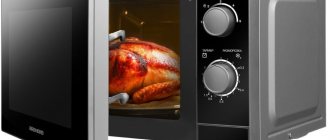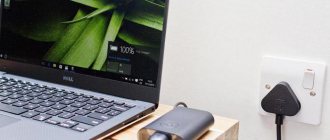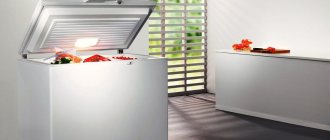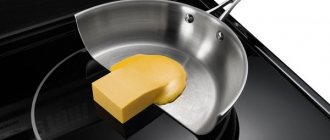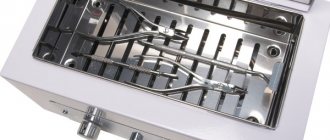Indicators such as efficiency, maximum heating temperature, heating rate determine how much power the device consumes. From the physical definition it follows that power is a quantity that determines the rate of transformation, change, and transfer of energy consumption. In the case of an oven, we are talking about converting electrical energy into heat, which means that the higher the power, the higher the speed of reaching a given temperature regime, which means the more economical the device will work - it will do its job faster.
Energy classes
The standard declared power of ovens is from 2.5 to 4 kW. There is also a division into energy consumption classes. Class A means very economical electricity consumption, B is an intermediate option, and C is simply an economical option. The “A+” and “A++” labels indicate minimum consumption levels. An oven of class A+ will save energy by 20-25%, and if you choose class A++, the savings will be 45-50%. Many people make the decision to buy an oven knowing how much an electric oven consumes.
Oven
The level of power consumption depends on the internal volume of the oven. To find out how much electricity an electric oven consumes, you need to know its volume. There are three categories into which ovens are divided according to their internal space:
- large volume - more than 65 liters;
- medium – starting from 35 liters;
- small volume – 12-35 liters;
If, for comparison, we take energy consumption class A and compare the three categories, we get that an oven with an internal volume of more than 65 liters consumes more than one kilowatt per hour, an average volume consumes 0.8, and a small volume consumes 0.6 kilowatts of electricity per hour. By carrying out simple calculations, you can find out how many kilowatts of energy the oven consumes during the month.
An example of calculating the energy consumption of an electric oven
Initial data:
- Electric oven model – Electrolux EZB52430AX;
- Volume – 60 liters;
- Energy consumption class – A (maximum electricity consumption for a model of this volume is 0.8 kW/h (data from Table 1.));
- The number of days during which it is planned to use the device is 15;
- The average cooking time per day is 1.5 hours;
- Region – Moscow region.
The monthly electricity consumption of such an electric oven will be equal to:
- Rel.month = 0.8×1.5x15x0.6 = 10.8 kW.
In monetary terms, with the electricity tariff in the Moscow region equal to 5.04 rubles/kW, the payment for the electricity consumed by the oven during the month will be:
Thus, by making the correct calculation using the above method, you can determine not only the feasibility of purchasing an electric oven of a certain model, but also plan the costs of paying for the electricity it consumes during the month. This will allow you to avoid purchasing a device that is too powerful and uneconomical and will lead to savings on the family budget.
Which is better - gas or electric oven:
An electric oven is a great helper for housewives of any level. it allows you to prepare delicious and healthy dishes. For anyone who loves baking and baked foods, an oven is an indispensable item. Modern electric ovens have many functions, including microwave ovens and grills. By purchasing one household appliance, you will be able to combine several others in it, and please yourself and your family with culinary masterpieces. But the question arises: won’t using an electric oven be a “ruin” for the family budget, just as an electric oven consumes so much?
Oven power indicators
Built-in ovens have more power than classic stoves. The built-in cabinet has a power of up to 4, and the stove has a power of up to 3 kilowatts.
The power of the device affects the following indicators:
- Electricity consumption – the higher the power, the lower the energy consumption.
- High power cooks food faster.
- Electricity costs are reduced at high power.
There is a relationship between oven power and maximum heating temperature. Cabinets with a power starting from 3.5 kW heat up to 500°C. But this feature is not useful in everyday life, since 220°C is sufficient for common dishes. Therefore, it is worth paying attention to ovens with a stated power of 2.5-3 kilowatts and a heating temperature of up to 250°C.
Oven power in kW: energy consumption classes of ovens
The power consumption of a technical device is understood as the relationship between the total speed of transmission, conversion and consumption of electricity and a single time interval - a second. According to the International System of Units, power is measured in Watts (1 W = J/s). Depending on the type of energy consumed, ovens are classified into electric and gas.
Electric oven model
The oven can be characterized by power falling within a wide range from 1 to 4 kW. Models with a value from 2 to 3 kW are simple electrical appliances that have become widespread due to their minimal power consumption. The power of electrical appliances is often in the range from 2.5 to 4 kW.
Correct and safe connection of the device in most cases requires a separate power line, represented by three-wire modern wiring. To connect devices with a power of more than 3.5 kW, you need either a terminal block or a separate socket that can withstand current from 16 to 32 amperes.
The relationship between the oven and the burner can either exist, through a combined panel, or not, due to an independent control panel. Models of this type have a standard height of 55 to 60 cm, and compact representatives - from 40 to 45 cm.
Classes of this type are both mechanical and electronic.
The electronic class of ovens is a large group of devices that have touch controls and a graphic display, as well as the ability to program the operating period, which implies the start time, duration of operation and the moment of its termination.
According to the degree of energy consumption, electric ovens are divided into representatives of classes A, B and C. In accordance with the gradation, the energy consumption class of the model can range from very economical to generally economical. The minimum level of power consumption reflects class “A+” and “A++”
As an example, the table shows energy consumption classes for small ovens.
Energy consumption classEnergy consumption, kW*h
| A | Less than 0.6 |
| B | 0,6-0,8 |
| C | 0,8-1 |
| D | 1-1,2 |
| E | 1,2-1,4 |
| F | 1,4-1,6 |
| G | over 1.6 |
Representatives of gas models of ovens can have a power of up to 4 kW, which negatively affects the volume of electricity consumption, while the power of classic electric stoves ranges up to 3 kW.
Dependence of temperature on power
There is a direct relationship between the maximum cooking temperature and the power of the electrical appliance, which affects the electrical consumption class of the appliance. Temperatures in ovens starting from 3.5 kW can reach up to 500°C.
But heating to such a high level is rather an unusual feature, since most dishes require only 220°C to cook. In connection with this optimal value, it is better to choose an oven with power 2.
5–3 kW and maximum temperature 250°C.
The market favorites in terms of power are represented by the following devices:
- Bosch ovens equipped with an ecological cleaning system EcoClean, they achieve extreme precision in the temperature range from 30 to 300 ° C;
- Samsung models are distinguished by a soft oven door opening system and Multi-rack technology, which ensures the comfort of changing modes during the cooking process;
- Electrolux ovens have built-in electronic timers and convenient temperature sensors;
- Gorenje representatives are distinguished by a variety of heating modes and steam cleaning of internal surfaces.
Safe operation and alternative solutions
For safe operation of the oven, resistance must be taken into account. To do this, the power indicated in the device’s passport data must be divided by the average 220 W. The result will be the required current strength.
When the heating system is supplied with gas, the parallel use of electrical appliances with a power exceeding 3.5 kW is prohibited.
This regulatory prohibition is due to the level of general house wiring, which is unsuitable for large voltage fluctuations and high power levels resulting from energy consumption. An alternative in this situation may be to have a gas model of an oven or a combination stove.
Recommendations for selection
Before choosing an electric oven, you should decide on the tasks that are important to you and the basic parameters of the device. Based on functionality, electric ovens can be divided into two types - standard and multifunctional. In the first, tubular heating elements located at the bottom and top of the chamber are used as heating elements.
In multifunctional models, four heating elements are installed - not only at the top and bottom, but also on the side walls. Additionally, they are equipped with a fan that circulates hot air inside the chamber, as well as several automatic cooking programs. The cost of such models will be higher than standard ones, but they allow you to prepare more delicious dishes, spending much less time on work.
When purchasing equipment, you should pay attention to the following parameters:
- dimensions and internal volume of the chamber;
- equipment, set of functions and modes;
- control method;
- energy consumption and power;
- cleaning method.
There should be no problems with choosing a color and design that matches the interior of your kitchen. Manufacturers offer a huge range of models with different colors and styles - from modern to classic and retro.
Installation
There are two types of electric ovens on sale - built-in and free-standing. The latter are usually small. They are placed on a table or bedside table and connected to a regular outlet, since the power of the devices is low.
Built-in ovens, in turn, can be dependent or independent. Dependents come complete with the hob and are installed only under it. This option is cheaper, but not always convenient. Independent devices are more popular, although they are more expensive. But they provide more options when planning the kitchen. The oven can be raised to the desired level so that you don’t have to constantly bend over while working.
Before purchasing an oven, be sure to find out what the condition of the electrical wiring in your home is. If the power of the selected device is more than 3.5 kW, and repair work has not been carried out for a very long time, the cable most likely will not withstand the required load of 16 amperes. In this case, there are two options - completely replace the wiring or refuse the purchase. And the main rule is that connecting an electric oven without grounding is strictly prohibited.
The built-in oven is installed in the niche of the kitchen set intended for it. Particular attention should be paid to the position of the device, because in 80% of cases the cause of equipment failure is incorrect installation, in particular the presence of distortions. Using a level, level the oven horizontally and vertically.
The distance from the bottom of the oven body to the floor should be at least 50 mm, ideally 80. Be sure to leave a gap of about 50 mm between the side walls and the kitchen unit. The distance to the rear wall is at least 40 mm. The socket must be installed near the appliance. The use of extension cords and adapters is strictly not recommended.
The size of the electric oven is an important aspect when choosing. But this parameter is not always given due attention. Users are accustomed to standard stove ovens and sometimes do not even pay attention to other options that optimize space.
Indeed, most electric ovens have standard dimensions. Their height and width are 60 cm, and their depth is about 55 cm. It is not difficult to place such a device in a medium-sized room. Usually it is easily installed in any kitchen set.
What should those who have a small kitchen, which already has a lot of all sorts of equipment, do? Should I refuse the purchase or sacrifice something else for the sake of the oven? Not at all necessary. You need to pay attention to non-standard models. If your family is small and you don’t use the oven very often, you can choose a model with a width of 45 cm and a height of 60 cm.
It is ideal for preparing small quantities of food. But large portions will have to be baked on two levels, which is not very convenient, since the cooking time increases. If this option does not suit you, purchase a model with a width of 60 cm and a height of 45 cm. This device allows you to save space in the kitchen and cook fairly large portions on standard baking sheets.
Those who are not limited by the size of the room can buy an electric oven with a width of 70-90 cm. But in our country such models are not particularly widespread, their choice is small, and the price is quite high.
We invite you to familiarize yourself with VTEK about how the disability commission works
Not only the size is important, but also the internal volume of the oven. For standard models it is usually 50-70 liters, for compact ones - about 40. Tabletop mini-ovens have a small volume - from 5 to 20 liters.
Control
Electric ovens can have three types of control - mechanical, electronic and touch. A model with mechanical control can be purchased quite inexpensively. Turning on the device, setting the temperature and operating time is done by turning the mechanical switches. As a rule, such devices are simple and cannot boast of special functionality.
More convenient, accurate and modern is electromechanical control, which involves the use of rotary controls and buttons. Such models already have a display that displays all the necessary parameters - temperature, time, mode, etc.
The most modern electric ovens have touch controls. By touching the icons on the panel, the user sets all the necessary parameters. The most advanced and expensive models are equipped with large color displays, which allow you to scroll through the menu, select modes and programs, and even load new recipes into the device’s memory. Such partings are still very expensive.
Oven manufacturers are keeping up with the times, creating devices that can be controlled remotely using a smartphone or tablet. Now you don’t have to spend all your time in the kitchen - your favorite gadget will help you control the preparation of a dish from a distance.
Oven power in money and kW/h
The time has come to choose
an oven for the kitchen.
Stylish design, modification, brand – all this is relevant. But! Pay attention to such a parameter as power. For residents of houses with old “weak” wiring, this problem is especially important. Just imagine the situation: you purchase a state-of-the-art oven with a power of 4 kW, and later it turns out that the maximum power of all appliances connected to the network can be no more than 4 kW.
You will either have to urgently change the wiring, or return the oven back and buy a simpler option. To avoid such a misunderstanding, it is advisable to study the power of the oven immediately before purchasing it. Check with your consultant how much electricity this device absorbs.
And in order to quickly and easily understand the topic, we suggest you read this article!
We study the types of ovens. What is the difference?
Depending on the type of energy used, ovens are electric
and
gas
. The power range of electric ovens ranges from 2.5 to 4 kW. For their correct and safe connection, in most cases a separate power line is required.
The oven can be dependent (have a combined control panel with a burner) and independent (have an autonomous control panel). The standard height is 55-60 cm, the height of compact models is 40-45 cm. Ovens also differ in energy consumption class.
Markings A, B, C correspond to a gradation from very economical to simply economical energy consumption levels. The “A+” and “A++” markings correspond to the minimum level of electricity consumption.
Built-in ovens have more power (up to 4 kW) compared to classic electric boards (up to 3 kW).
“Market Leaders” – 4 of the most powerful manufacturers. Why they are loved.
1
Bosch ovens (average cost from RUB 16,000): highest quality;
EcoClean environmental cleaning system; accuracy of temperature range from 30 to 300° C; simplicity and ease of use; available mode table; stylish design. 2
Samsung ovens (average cost from 10,000 rubles): ergonomics;
energy saving system; soft oven door opening system; Multi-rack technology for conveniently changing cooking modes; competitive price. 3
“Electrolux” ovens (average cost from 14,000 rubles): the presence of built-in electronic timers and temperature sensors;
touch control; wide range of colors; design, thought out to the smallest detail. 4
“Gorenje” ovens (average cost from 16,000 rubles): cleaning the internal surface with steam; multifunctionality; a large number of heating modes; impeccable style.
"Dossier". Power consumption and connection power - what's the difference?
The power consumption of an electrical appliance is the rate of transmission, conversion and consumption of energy per unit of time.
School physics course! But to put it simply, the higher the power of the device, the less time it will spend working and the more effective the process itself will ultimately be. The savings are obvious! Let's give a simple example.
Accordingly, when choosing between electric kettles with a power of 100 Watt and 1000 Watt, it is better to give preference to the second one. The first one will heat the water incomparably longer, and we will pay incomparably more for light.
All household appliances with a power above 1.5 kW are no longer considered low-power. In this case, three-wire modern wiring is required. Then equipment with a power of up to 3.5 kW can be connected to ordinary, but high-quality “Euro” sockets.
But in general, higher power devices, in particular ovens, must be connected either through a terminal block or through a special socket, or even better, separate wiring lines must be laid. After all, safety comes first! With this power, the required current is 16 amperes.
If you increase the power of the device, you need to count on a current of 32 amperes.
The connection power shows how much current is required for the safe operation of this device. For example, the instructions indicate that the required connection power is 3580 W. We calculate the current strength. To do this, divide 3580 W by 220 W (standard network voltage indicator) and get the figure 16.3 A.
Safe operation and alternative solutions
For safe operation of the oven, resistance must be taken into account. To do this, the power indicated in the device’s passport data must be divided by the average 220 W. The result will be the required current strength.
When the heating system is supplied with gas, the parallel use of electrical appliances with a power exceeding 3.5 kW is prohibited.
This regulatory prohibition is due to the level of general house wiring, which is unsuitable for large voltage fluctuations and high power levels resulting from energy consumption. An alternative in this situation may be to have a gas model of an oven or a combination stove.
Parameters and characteristics
The main parameter of these devices is the power consumption of the electric oven. This consumption indicator is in the range of 1-4 kW, and models with 2-3 kW power are most widespread. More powerful ovens require the installation of a separate outlet that can withstand significant current.
Many electrical appliances of this type are built-in, including the popular and well-known Bosh oven models. Their height is in the range of 55-60 cm, less often – 40-45 cm. All of them are equipped with a convenient control panel that displays all the necessary information. Cooktop and oven power is measured in watts (W) or kilowatts (kW) and depends largely on the availability of additional features.
In accordance with the amount of energy consumption, all cabinets are divided into 7 classes:
- 1st – below 0.6 kW;
- 2nd – 0.6-0.8 kW;
- 3rd – 0.8-1 kW;
- 4th – 1-1.2 kW;
- 5th – 1.2-1.4 kW;
- 6th – 1.4-1.6 kW;
- 7th – over 1.6 kW.
Leading manufacturers
What benefits do popular oven manufacturers offer?
- Bosch is a leader in power and energy savings. Bosch ovens are equipped with the EcoClean cleaning system. Heating temperature – from 30 to 300°C.
- Samsung equips the models with a smooth door opening system and technology that ensures a gradual transition from one mode to another.
- Electrolux ovens have convenient temperature sensors and timers.
- Gorenje provides a large selection of heating modes and steam cleaning from the inside of the oven, which makes cleaning easier.
If it is important to you how much energy the oven consumes, choose it with special care. Wisely selected equipment will delight you for many years with productivity and efficiency.
Large selection of models
The manufacturer offers models of electric ovens in both modern minimalist design with electronic control and retro style. The color of the instruments is black, white, ivory, gray. The laconic and attractive appearance always remains relevant and successfully complements any interior.
Our online store offers customers a large selection of Lex electric ovens with a manufacturer's warranty. For our clients - a convenient catalog with a multi-stage filter, affordable prices, the ability to order targeted delivery in Moscow, competent advice from managers.
Tags: what, power, electric oven
« Previous entry
Safe Operation
It is better to buy a product with double or triple glass in the door and the ability to lock it. This is especially important for families with small children. The glass will protect against burns, and the lock will protect against accidental opening of the door by small cooks.
When operating the oven, follow the following safety precautions:
- carefully study and follow the operating instructions;
- do not leave a working device unattended;
- when using baking sheets, wear protective gloves;
- Do not store flammable items near the cabinet.
Power of an electric oven: how much kilowatt it consumes, energy consumption class
The oven, along with the dishwasher, grill, hob, microwave and water heater are the main consumers of electricity in the apartment. The cost of paying for utilities directly depends on which unit to buy and how intensively to use it.
Let's look at how to choose an oven wisely and use it safely and economically.
Oven power indicators
The power of an electric oven is measured in basic units - Watts (abbreviated W) and more often derivatives - kilowatts (kW). The average amount of energy consumed by household appliances is measured using electrical meters.
A built-in electric oven consumes from 0.6 to 3.65 kW. The average power of an electric oven is approximately 1.6 kW.
What is connecting power
This characteristic includes the power consumed by all heating elements, fans, backlight and electronic control unit.
Important! Electrical wiring, circuit breakers, sockets, etc. must be designed for connecting the connecting power.
Ovens are usually used together with hobs (electric or gas appliances) or independently.
Information about the connecting power of the built-in electric oven, the parameters of the electrical wiring and circuit breakers required for connection is given in the table below:
| Type of equipment | Mains voltage, V | Maximum power consumption, kW | Copper cable cross-section for single-phase connection | Copper cable cross-section for three-phase connection | Circuit breaker parameters |
| Oven + electric hob | 220/380 | No more than 11 | Up to 8.3 kW/4 mm2, PVS cable 3x48.3–11 kW/6 mm2, PVS cable 3x6 | Up to 9 kW/2.5 mm2, PVS cable 3x2.59–15 kW/4 mm2, PVS cable 3x4 | Separate at least 25A/32A/40A RCD |
| Electric hob | 220/380 | 6–11 | Up to 8.3 kW/4 mm2, PVS cable 3x48.3–11 kW/6 mm2, PVS cable 3x6 | Up to 9 kW/2.5 mm2, PVS cable 3x2.59–11 kW/4 mm2, PVS cable 3x4 | Separate at least 25A/32A/40A RCD |
| Oven | 220 | 3,5–6 | Up to 4 kW/2.5 mm2, PVS cable 3x2.54–6 kW/4 mm2, PVS cable 3x4 | Up to 4 kW/2.5 mm2, PVS cable 3x2.54–6 kW/4 mm2, PVS cable 3x4 | 16A, 25A |
| Gas hob | 220 | No more than 3 | 1.5 mm2, PVS cable 3x1.5 | 1.5 mm2, PVS cable 3x1.5 | 16A |
RCD - residual current device. It is a fast-acting means of protecting a person from the effects of electric current and fire in electrical wiring when faults occur in it or connected electrical appliances.
The RCD compares the current flowing to the electricity consumer with the current returning from it. If they are not equal, the device turns off the voltage supply to the consumer. An RCD is installed in the distribution board near the electric meter.
Important! If the electrical wiring parameters in the house do not correspond to the connecting power of the purchased oven, you will have to choose another unit or redo the wiring.
Oven energy consumption classes
How much energy an electric oven consumes depends on its volume: the larger it is, the greater the power required for heating.
The amount of energy consumed by the device is characterized by the energy efficiency class, which is indicated on the label and in the user manual. The power of the built-in electric oven directly depends on the volume:
| Energy class | Power consumption for an oven with a volume of less than 35 liters, W | Power consumption for an oven with a volume of more than 35 liters, W |
| A | less than 0.6 | less than 0.8 |
| B | 0,6–0,8 | 0,8–1,0 |
| C | 0,8–1 | 1,0–1,2 |
| D | 1–1,2 | 1,2–1,4 |
| E | 1,2–1,4 | 1,4–1,6 |
| F | 1,4–1,6 | 1,6–1,8 |
| G | more than 1.6 | more than 1.8 |
How to save energy
When purchasing, choose a model with minimal electricity consumption. When operating, adhere to simple rules:
- if the house has a preferential tariff for paying for electricity at night, if possible, prepare dishes in the oven at this time (details about prices are provided by the resource supplying organization);
- use the unit for the minimum required time;
- do not run cleaning modes for work surfaces with high energy consumption (hydrolysis and pyrolytic) too often;
- the preheating mode is used only when it is provided for in the recipe of the dish being prepared;
- if there are long-cooking dishes in the cabinet, the equipment is turned off 5–10 minutes before the control date: during this time the food will reach its proper condition, but no electricity will be consumed.
When cooking, make sure that the device door is tightly closed.
How to choose an oven
Choosing an oven is a responsible matter. Equipment is purchased for long-term use, and it will not be possible to add missing functions to it after purchase.
Cabinet type
Structurally, ovens are divided into 2 groups: dependent and independent. The first ones, as a rule, are located under the hob and are connected to it by connecting wires. This design is similar to a regular stove; the control panel is common to both devices and is located on the front of the cabinet.
The latter can be mounted in any convenient place, since they are in no way connected with the hob. As a rule, such devices are built into a pencil case at eye level to make it convenient to observe cooking.
Important! In the latter case, pay attention to good ventilation of the pencil case and thermal insulation of the device body from furniture. Otherwise there is a risk of damage or fire.
When choosing a dependent option, make sure that the products are compatible, even if they are made by the same manufacturer. For this purpose, special tables have been created, which are posted on the official website of the manufacturer.
In the independent version, the hob comes with any number of burners; in the dependent version, most manufacturers offer only a four-burner version.
Combined models are available: a gas panel with an electrical cabinet, but their range is small.
Dimensions
The most common ovens have standard dimensions of 600x600x560 mm. Narrow (600x450x560 mm) and wide (600x900x560 mm) models, low (380–500 mm high) and high (900 mm) models are available.
The choice of product dimensions depends on its purpose and the size of the kitchen furniture. The selection of functionality is based on the same ideas.
Functional
The capabilities of the manufactured units are very diverse. Let's look at the most significant of them.
Cleaning function
There are traditional, catalytic, hydrolysis and pyrolytic methods for cleaning the internal surfaces of the oven.
The traditional method is manual cleaning of contaminants using conventional detergents.
The catalytic unit is equipped with special panels on which copper or manganese oxide is applied. The pores contain a catalyst that ensures the decomposition of fat into carbon, water and organic matter. Cleaning occurs when using the device; the surfaces are simply wiped with a cloth.
Important! Catalytic panels have a limited service life, so they will have to be replaced at the intervals specified in the instruction manual.
The hydrolysis cleaning method uses water and detergent, which are poured into a baking tray. It is placed in the included product. The resulting steam softens the dirt; the surfaces are wiped with a cloth.
The pyrolytic method is fully automatic, based on burning food residues at high temperatures, which turn into ash. Devices that use pyrolysis are the most expensive.
The last two cleaning methods involve additional energy costs, and the cost of the ovens in which they are implemented is the highest.
Culinary functionality
The following operating modes are used in ovens.
- Grill. There are devices with or without forced convection. Convection is the mixing of air in the work area using fans. Thanks to this, the air heats up more evenly and food cooks faster. In this mode, baked goods, meat, fish, and chicken are prepared. Appliances with convection are more expensive than those without.
- Defrost at room temperature . The heating elements do not work, and the food is blown by fans.
- Fast defrosting. One heating element operates at minimum power. The fan blows warm air through the working volume.
- Standard mode. The heating elements are used depending on the cooking program.
- Accelerated mode - standard plus fans.
- Fast multi-level mode . All heating elements and fans are activated. The products are on different baking sheets at different heights. This allows you to cook two different dishes without their flavors mixing.
- Browning mode . Only the top heating element is used, which creates a crispy crust.
- Microwave mode. Ovens are produced with a source of high-frequency electromagnetic field - a magnetron. This allows you to quickly reheat ready meals.
- Steaming. The steam generator in the model is used as a double boiler - as a result, the maximum amount of useful substances is preserved in the products.
Additional options
These functions simplify the use of the device and improve the quality of prepared dishes:
- The PerfectRoast option allows you to use the temperature probe to control the temperature at three points of the dish with an accuracy of 1°C. This will ensure high quality frying of the products. The device is purchased separately.
- A spit is a useful accessory for cooking kebabs and barbecues. If the oven has forced convection, it is not necessary to use a spit.
Safe Operation
It is better to buy a product with double or triple glass in the door and the ability to lock it. This is especially important for families with small children. The glass will protect against burns, and the lock will protect against accidental opening of the door by small cooks.
When operating the oven, follow the following safety precautions:
- carefully study and follow the operating instructions;
- do not leave a working device unattended;
- when using baking sheets, wear protective gloves;
- Do not store flammable items near the cabinet.
Conclusion
Anyone who can work with their hands can install the oven using the user manual. However, if you are not an expert in electrical engineering, it is better to entrust electrical installation work to a professional. If problems are detected, stop using the device and call a service technician.
How much does the oven consume: general technical characteristics
Electric and gas ovens are very popular. There is a large selection of products on the market from different manufacturers. How much electricity does an oven consume, what characteristics should you pay attention to first?
Ovens are divided into electric and gas. Many professionals and amateurs prefer electric ovens. The heating elements in such devices are located not only on the bottom, but on the sides and top.
How to choose an oven
Choosing an oven is a purely individual matter. Here are the aspects that influence the decision to purchase a particular model, and their significance in each case will depend only on you:
- price;
- built-in oven or not;
- preference for one brand or another;
- ease of use;
- intuitive menu interface;
- energy efficiency;
- dimensions;
- design;
- functionality.
Decide what is most important to you and start your selection based on the most significant characteristics. As additional restrictions are imposed on parameters that are less significant to you, the number of options will decrease.
In the end, you can choose the model that, all other things being equal, will suit you better in design, have better reviews, or be cheaper than competitors.
Operating modes and wiring
Operating modes are adjusted in accordance with individual programs included in each oven. Under normal conditions, consumption will be approximately 1.65 kW. However, when using the fast heating function, activated by a special button, energy consumption will very quickly reach its maximum level and reach 3.65 kilowatts. Therefore, this mode should not be used unless necessary.
However, you still have to turn it on. So, just before you start connecting the oven, manufacturers recommend warming it up well to eliminate factory odors. To do this, the cabinet must operate in quick heating mode for some time, but not less than 1 hour. If the home electrical network cannot withstand high loads, the oven will have to warm up for a longer time.
In new apartments or when carrying out major renovations in old housing, special attention is paid to electrical wiring, which is pre-designed for the installation of powerful household appliances. The cross-section of wires and cables is selected based on the total power of the equipment provided for calculations. The same applies to automatic circuit breakers and circuit breakers that operate at 15 amperes, corresponding to the standard power of devices within 3 kilowatts. Separately, we should mention the outlet, which must withstand at least 8 amperes. These data are indicated on the markings on the product body.
How to save additional energy
During operation, the oven is able to independently maintain the required temperature level using special electronic control equipment.
However, there are additional ways by which power consumption can be significantly reduced:
- Preheating the oven should only be used in cases specified in the operating tables or recipes for preparing individual dishes.
- For baking, it is recommended to use dark-colored molds that absorb heat well.
- During cooking, cabinet doors should be kept as tightly closed as possible.
- If you need to bake several pies at once, they should be placed in the cabinet one by one. When the first pie is ready, the next one should be immediately placed inside the cabinet while it is hot. Due to this, the overall cooking time is significantly reduced. Overall costs are also reduced.
- When there are long-cooking dishes in the cabinet, it should be turned off approximately 10 minutes before the target date. The dish will be completely conditioned by the energy of the residual heat.
We invite you to familiarize yourself with how many people are in a company of soldiers in Russia


